Sea & Sea MDX-PRO Mark III underwater housing review
Sea & Sea MDX-PRO MKIII Underwater Housing for Canon 1D Mark III and 1Ds Mark III
Review by Eric Cheng and Don Kehoe
The Sea & Sea MDX-PRO MKIII underwater housing for the Canon 1D Mark III and 1Ds Mark III digital SLR is beautifully machined. It appears to be machined from a solid block of aluminum, and has a nice, smooth finish (flat, black, hard anodizing).

Sea & Sea underwater housing for 1D/1Ds Mark III
with optical glass dome port and Ikelite DS-125 strobes

Sea & Sea 1D/1Ds Mark III housing, open view of front piece
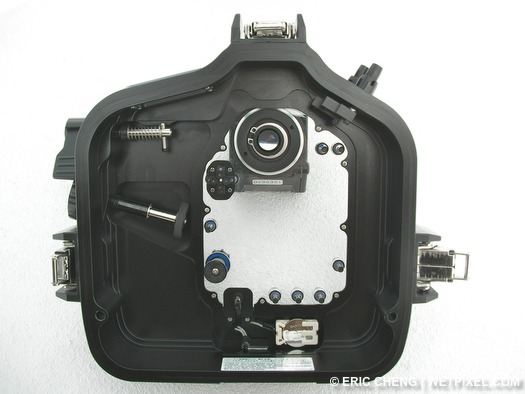
Sea & Sea 1D/1Ds Mark III housing, open view of back piece
The housing has a leak detector installed, which is a nice feature. However, the detector's battery is mounted dangerously low on the back half of the body. I would have preferred it to be mounted a bit higher so minor leaks don't have the potential to destroy it.
The camera's rear LCD was easy to see through the large plastic window in the back of the housing.
The housing has been cut for an automatic focus light bulkhead, but there is no bulkhead in place. If you use this hole for an accessory bulkhead for any reason (e.g. remote shutter switch), you should be aware that large dome ports will cover the bulkhead and will not allow a connector to be inserted. However, the smaller optical glass dome port does allow access to the bulkhead opening.
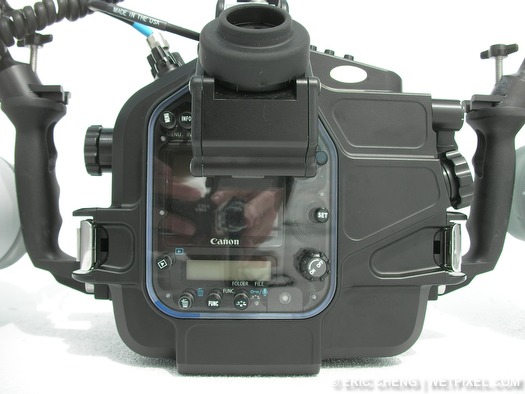
Sea & Sea 1D/1Ds Mark III housing with
INON 45-degree viewfinder custom-installed by Backscatter

Sea & Sea 1D/1Ds Mark III housing, close view of back
with INON 45-degree viewfinder installed
The 1D Mark III and 1Ds Mark III is mounted on a low-profile camera base plate. It is different than the dovetail plate used in past Sea & Sea housings, and slides in easily on top of a grooved, fixed plate inside the housing. A large thumbscrew holds the two plates together, and is easy to tighten and loosen. The thumbscrew does come off of the base plate, so it's probably a good idea to keep a spare somewhere in your accessory kit.
Without a zoom gear attached, the camera and lens -- with mounting plate attached -- dropped perfectly into the housing. With a zoom gear attached to a lens, I had to wiggle the zoom knob a bit in order to get the gears to mesh together, which then allowed the camera to drop into proper position. It is still easy to do, but it can be difficult unless you are aware of the issue.
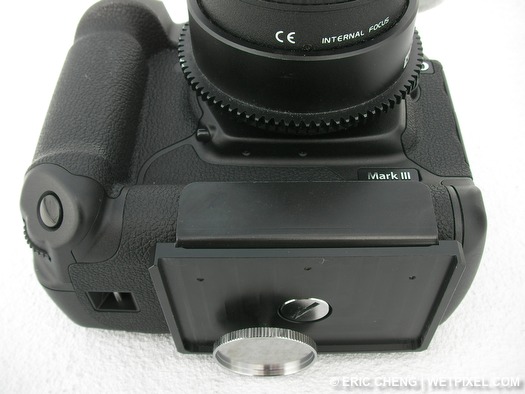
Canon 1D Mark III with base place attached
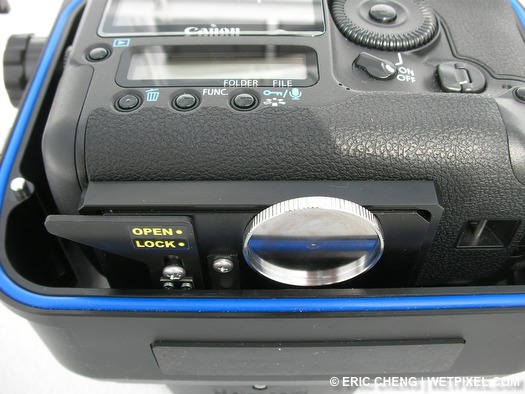
Sea & Sea 1D/1Ds Mark III housing, view of installed body tray and port lock

Sea & Sea 1D/1Ds Mark III housing, open back with Canon 1D Mark III installed
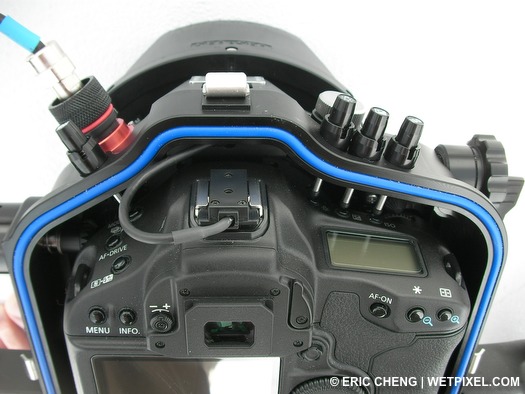
Sea & Sea 1D/1Ds Mark III housing, view of hotshoe
Assembly of the new housing out of the box was straightforward, with no adjustments necessary. The housing has two sync cord bulkheads, one wired for use with the TTL converter, and one wired for non-TTL use. We used Ikelite N5-to-Ike sync cords which are designed for manual use; these worked well when attached to both bulkheads. However, our Y-cable would screw in properly only in the TTL bulkhead. In the other bulkhead, there was significant resistance, causing us to stop screwing it in rather than risk damaging the plastic sync cord end. We're not sure if the problem was with the sync cord or the bulkhead, but it is something we still need to figure out.

Sea & Sea 1D/1Ds Mark III housing, top view. The red bulkhead is designed for
the TTL converter. The one of the right is designed for normal use.
next: ergonomics